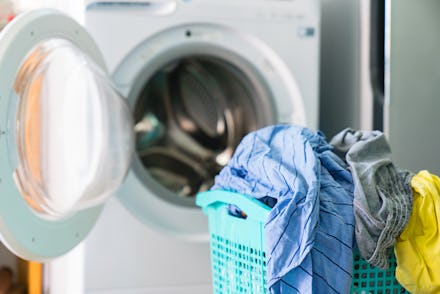How to do your laundry during a pandemic

A few weeks ago, a friend asked if she could come use my washing machine. “I love you and no,” I said. I felt a little weird, at the time, about my strict no-people-in-the-house policy, but it turns out that I was just an early adopter. Now everyone is trying to figure out how to keep themselves and their clothes clean without increasing the risk of infection for themselves or others. Here are some best practices for doing your laundry during the COVID-19 pandemic, whether you’re in the burbs with the luxury of your own machine or in a big city where laundromats are closed.
First of all, know that clothes are not the riskiest surfaces you come into contact with. Put simply, the novel coronavirus travels through respiratory droplets. It may be able to live for up to three days on smooth surfaces, like plastic and steel, but there have been no documented cases of COVID-19 infection from contact with objects thus far, according to the CDC.
Basic laundry precautions
“You really want to be sure you keep your clothes clean and keep using the same precautions you do with other items in the home,” says Alison Mitzner, a pediatrician and family wellness expert in New York City. “To start, avoid touching your face — nose, mouth, and eyes — when handling laundry. It is possible that the virus may remain on clothes for a period of time.” Mitzner says we should consider clothes contaminated and keep them in a separate bag until you’ve washed them.
It’s important not to shake out dirty clothes, as this could expel infectious particles into the air.
The CDC recommends laundering all items on the highest heat possible. That means that your lacy undergarments and other delicate items may need to stay in the back of the closet for now (your hot Zoom date will likely forgive you for not being decked out in your most scintillating finery). You should also wear gloves when handling dirty laundry or wash your hands after touching it. Don’t forget to launder your hamper bags, the CDC reminds us. If you can’t, use a trash bag as a liner if you want to be extra careful. Also, all the experts I spoke with reminded me that it’s important not to shake out dirty clothes, as this could expel infectious particles into the air.
“From what we know right now, normal laundry procedures are sufficient,” Rodney Rohde, an epidemiologist and professor of clinical laboratory science at Texas State University, tells Mic. “Don’t go ruining all your clothes by boiling everything. That will add more stress and anxiety that none of us need right now.”
If someone is sick in your home
If someone is ill in your home, their laundry can still be washed with yours, according to the CDC, but many experts recommend using more caution. “COVID-19 patients in the hospital have their laundry separated from regular patients,” says Ross Kopelman, a New York City-based physician and host of the podcast MedChatMonday. “Their laundry is sent out to an external cleaner out of fear that viral particles can continue to live on the sheets and be spread to other patients.” This is done out of an abundance of caution in a vulnerable environment, but it’s worth noting. Experts who spoke to The New York Times agree: The laundry of unwell folks should be limited to items that are easy to launder, their laundry should be kept in a separate disposable bag from other laundry, and it should be washed separately.
If you are laundering the clothes of a person infected with COVID-19, you should definitely wear disposable gloves while handling it, per the CDC.
If you share laundry equipment
If you don’t have laundry facilities in your home, yes, you can hand wash in your sink or tub, but it’s best if you can get your water temperature up to at least 80 degrees, Rohde says. If you share laundry equipment with other folks, establish a laundry schedule so that everyone can do their laundry separately. You’ll want to get in and out of shared spaces as quickly as possible, Jack Caravanos, clinical professor at the School of Global Public Health at New York University, told the Times, so do your sorting before you leave home and your folding when you return.
"The more challenging issue is not the laundry itself, but social distancing and contact with potentially contaminated surfaces and people in the laundromat."
When it comes to laundromats and other shared facilities, “surfaces matter,” Rohde tells Mic, and says that he is trying to start a #surfacesmatter social media campaign to help people remember to be aware of all the surfaces they touch. Handwashing is the most important part of keeping surfaces clean, Rohde reminds us, but you should also be careful to sterilize surfaces before and after you touch them. Georgine Nanos, a family medicine doctor in Encinitas, California, agrees. “The more challenging issue is not the laundry itself, but social distancing and contact with potentially contaminated surfaces and people in the laundromat,” she says.
Cutting down on risk
One way to cut back on both risk of infection and also the amount of laundry you have to do is to have inside clothes and outside clothes. “It is a good idea to change your clothing when you get home, put the clothing in the laundry right away, and remove your shoes at your door entrance,” Mitzner tells Mic. If you use public transportation, come into contact with a lot of people in the course of your work, or if someone coughs or sneezes on you, you should change into clean clothes as soon as you get home.
And for the 9 millionth time, wash your hands.